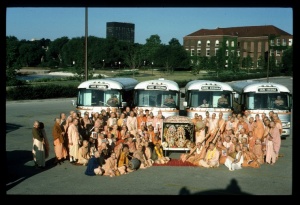CC Madhya 21.140: Difference between revisions
m (1 revision(s)) |
No edit summary |
||
| Line 1: | Line 1: | ||
{{ | [[Category:Sri Caitanya-caritamrta - Madhya-lila Chapter 21|C140]] | ||
<div style="float:left">'''[[Sri Caitanya-caritamrta|Śrī Caitanya-caritāmṛta]] - [[CC Madhya|Madhya-līlā]] - [[CC Madhya 21|Chapter 21: The Opulence and Sweetness of Lord Śrī Kṛṣṇa]]'''</div> | |||
<div style="float:right">[[File:Go-previous.png|link=CC Madhya 21.139|Madhya-līlā 21.139]] '''[[CC Madhya 21.139|Madhya-līlā 21.139]] - [[CC Madhya 21.141|Madhya-līlā 21.141]]''' [[File:Go-next.png|link=CC Madhya 21.141|Madhya-līlā 21.141]]</div> | |||
{{CompareVersions|CC|Madhya 21.140|CC 1975|CC 1996}} | |||
{{RandomImage}} | |||
==== TEXT 140 ==== | ==== TEXT 140 ==== | ||
<div | <div class="verse"> | ||
smita-kiraṇa-sukarpūre, paiśe adhara-madhure, | :smita-kiraṇa-sukarpūre, paiśe adhara-madhure, | ||
sei madhu mātāya tribhuvane | :sei madhu mātāya tribhuvane | ||
vaṁśī-chidra ākāśe, tāra guṇa śabde paiśe, | :vaṁśī-chidra ākāśe, tāra guṇa śabde paiśe, | ||
dhvani-rūpe pāñā pariṇāme | :dhvani-rūpe pāñā pariṇāme | ||
</div> | </div> | ||
| Line 14: | Line 18: | ||
==== SYNONYMS ==== | ==== SYNONYMS ==== | ||
<div | <div class="synonyms"> | ||
smita- | ''smita-kiraṇa''—the shining of Kṛṣṇa’s smile; ''su-karpūre''—compared to camphor; ''paiśe''—enters; ''adhara-madhure''—within the sweetness of the lips; ''sei madhu''—that ambrosia; ''mātāya''—maddens; ''tri-bhuvane''—the three worlds; ''vaṁśī-chidra''—of the holes in the flute; ''ākāśe''—in the space; ''tāra guṇa''—the quality of that sweetness; ''śabde''—in sound vibration; ''paiśe''—enters; ''dhvani-rūpe''—the form of sound vibration; ''pāñā''—obtaining; ''pariṇāme''—by transformation. | ||
</div> | </div> | ||
| Line 21: | Line 25: | ||
==== TRANSLATION ==== | ==== TRANSLATION ==== | ||
<div | <div class="translation"> | ||
“His slight smiling and fragrant illumination are compared to camphor, which enters the sweetness of His lips. That sweetness is transformed and enters into space as vibrations from the holes of His flute. | “His slight smiling and fragrant illumination are compared to camphor, which enters the sweetness of His lips. That sweetness is transformed and enters into space as vibrations from the holes of His flute. | ||
</div> | </div> | ||
__NOTOC__ | |||
<div style="float:right; clear:both;">[[File:Go-previous.png|link=CC Madhya 21.139|Madhya-līlā 21.139]] '''[[CC Madhya 21.139|Madhya-līlā 21.139]] - [[CC Madhya 21.141|Madhya-līlā 21.141]]''' [[File:Go-next.png|link=CC Madhya 21.141|Madhya-līlā 21.141]]</div> | |||
__NOTOC__ | |||
__NOEDITSECTION__ | |||
Revision as of 09:22, 9 September 2021

His Divine Grace
A.C. Bhaktivedanta Swami Prabhupada
A.C. Bhaktivedanta Swami Prabhupada
TEXT 140
- smita-kiraṇa-sukarpūre, paiśe adhara-madhure,
- sei madhu mātāya tribhuvane
- vaṁśī-chidra ākāśe, tāra guṇa śabde paiśe,
- dhvani-rūpe pāñā pariṇāme
SYNONYMS
smita-kiraṇa—the shining of Kṛṣṇa’s smile; su-karpūre—compared to camphor; paiśe—enters; adhara-madhure—within the sweetness of the lips; sei madhu—that ambrosia; mātāya—maddens; tri-bhuvane—the three worlds; vaṁśī-chidra—of the holes in the flute; ākāśe—in the space; tāra guṇa—the quality of that sweetness; śabde—in sound vibration; paiśe—enters; dhvani-rūpe—the form of sound vibration; pāñā—obtaining; pariṇāme—by transformation.
TRANSLATION
“His slight smiling and fragrant illumination are compared to camphor, which enters the sweetness of His lips. That sweetness is transformed and enters into space as vibrations from the holes of His flute.